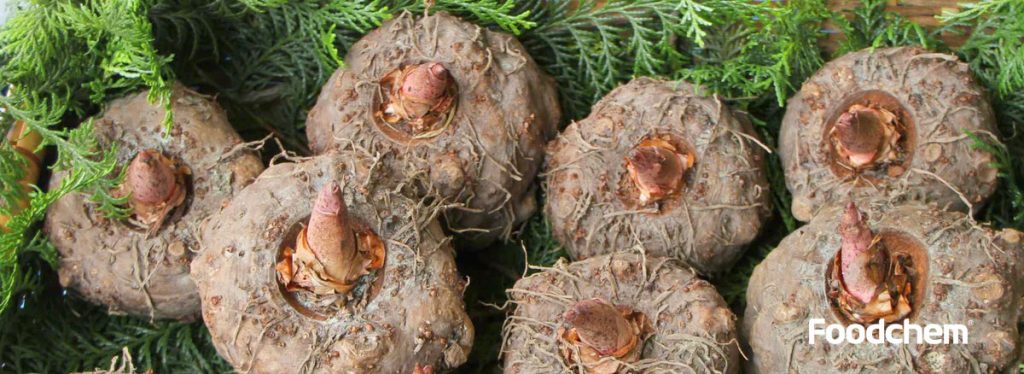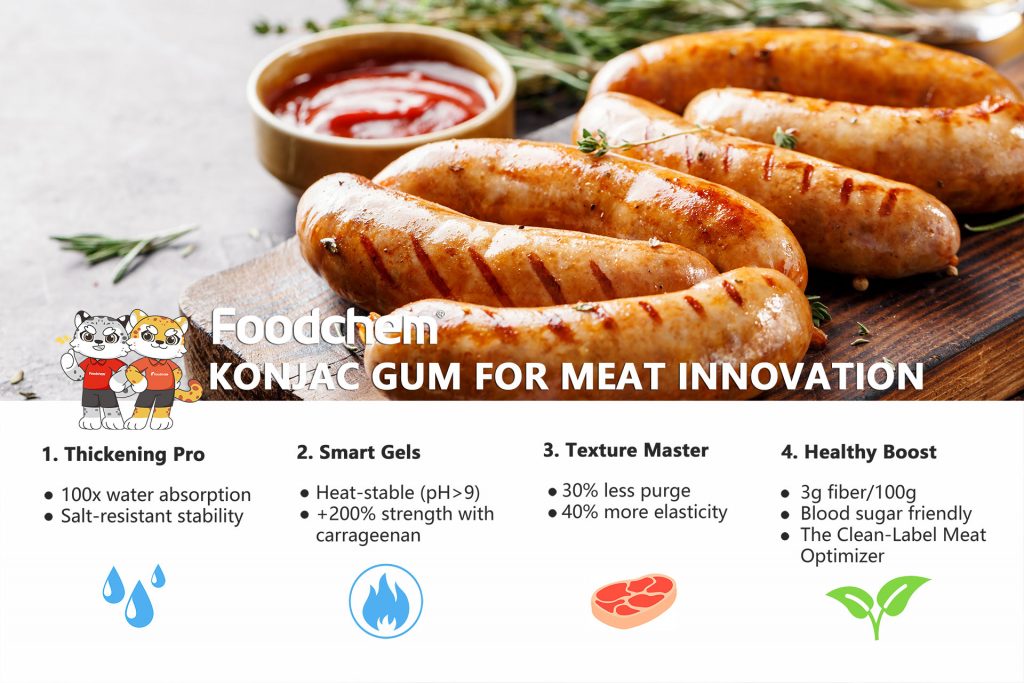FOODCHEM
Share:

News
Functional Properties of Konjac Gum and Its Application in Meat Products
Konjac gum, extracted from the tubers of the konjac plant (Amorphophallus konjac), is a natural polysaccharide primarily composed of Konjac Glucomannan (KGM). As a high-molecular-weight polysaccharide, konjac gum possesses excellent functional properties including thickening, gelling, binding, and water-holding capabilities. It exhibits significant synergistic effects with various other food gums (such as carrageenan and xanthan gum), making it a highly promising ingredient in the food industry.

I. Core Functional Properties
- Thickening and Stabilizing: Konjac gum can absorb water and expand up to approximately 100 times its volume. A 1% solution exhibits high viscosity (demonstrating non-Newtonian fluid characteristics). Its viscosity is minimally affected by salts. It effectively increases the viscosity of food products, improves mouthfeel, and stabilizes suspensions and emulsions.
- Gelation Properties:
a. Thermal Stability: Heating and subsequent cooling forms a fluid solution (at pH 5.0-7.0). Under alkaline conditions, deacetylation occurs, forming thermally stable, elastic gels.
b. Synergistic Gelation: Combined with xanthan gum, konjac gum forms thermally reversible gels under neutral conditions. Gel strength and elasticity increase with higher gum concentration and longer gelation time (but decrease with higher metal ion concentrations). Synergy with carrageenan significantly enhances gel strength and elasticity. - Binding Capacity: Konjac gum effectively enhances the internal binding force of products.
- Dietary Fiber Function: As a soluble dietary fiber, konjac gum offers physiological benefits such as aiding weight management and lowering blood lipids.
II. Specific Applications in Meat Products
- Meat Analogs: Leveraging its water-holding capacity, swelling properties, and shaping ability, konjac gum can partially replace fat in the production of low-fat, high-fiber meat analogs (e.g., vegetarian tripe slices, artificial sea cucumber, imitation chicken). For instance, imitation chicken with desirable texture and nutrition can be produced using a main ingredient ratio of konjac gum: soy protein = 3:2, supplemented with sodium carbonate, chicken extract, glutinous rice flour, etc.
- Restructured Meat Products: Utilizing its binding properties, konjac gum effectively improves the cohesion of restructured meat products, reduces water exudation (purge), and enhances texture. Examples include:
a. Adding approximately 2% konjac gum provides ideal binding for meat by-products.
b. Incorporating KGM and KSAP (konjac soluble alkaline polysaccharide) into restructured poultry ham optimizes product quality (reducing purge loss), forms a dense network structure, significantly improves elasticity and cohesiveness, and lowers hardness. - Meat Product Preservation: Konjac gum's film-forming ability makes it suitable for edible coating applications. Gel films formed from konjac gum solutions act as barriers against air and microorganisms, extending shelf life. Research indicates:
a. Konjac flour coatings demonstrate excellent preservation effects on chilled pork.
b. Compared to other treatments (such as chitosan coating), konjac coatings more effectively maintain meat pH and enzyme activity, extending the shelf life at prime freshness to approximately 7 days. They offer advantages of safety and biodegradability.

III. Conclusion
China boasts abundant konjac resources and a long history of cultivation and consumption. With advancements in food science and technology, coupled with growing consumer demand for healthy and natural foods, konjac gum holds immense potential in the food industry, particularly in meat products, due to its unique functional properties. Notably, as a source of functional dietary fiber (KGM), it aids in promoting intestinal motility and slowing sugar absorption, offering auxiliary preventive benefits for conditions like obesity and diabetes. Key application directions include:
- Healthier Products: Replacing fat to develop low-fat, high-fiber meat products catering to specific dietary needs.
- Resource Utilization: Enhancing the quality of restructured meats and improving the utilization of meat by-products.
- Preservation Innovation: Providing a safe and effective natural preservation solution.
As living standards rise and health consciousness strengthens, konjac gum will find increasingly widespread application in improving the quality of meat products, expanding their functionality, and enhancing their added value.





